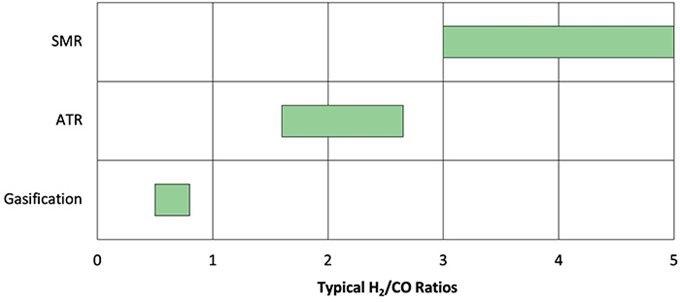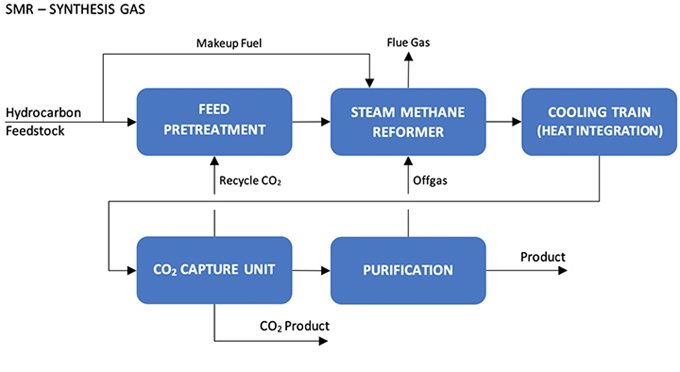Synthesis gas is composed primarily of hydrogen and carbon monoxide, but can also contain other components such as methane and carbon dioxide. Over the past 50 years, Lummus has designed and built plants around the world that produce synthesis gas, high-purity hydrogen, carbon monoxide, carbon dioxide or a combination of the four. Synthesis gas plant references range in capacity from less than 1 MMSCFD* (1100 NCMH**) to 50 MMSCFD* (55,800 NCMH**).
Lummus’ synthesis gas solutions include hydrogen/carbon monoxide (HYCO) plants and carbon monoxide (CO) plants that utilize steam methane reforming (SMR), auto-thermal reforming (ATR), gasification (E‑Gas™) technologies and carbon dioxide (CO2) capture. For customers requiring high purity hydrogen streams, Lummus Technology’s Green Circle is a market leader in hydrogen production plants.
The choice of process technology depends on the desired H2/CO ratio, feedstock, oxygen availability, capital cost, operating cost, environmental considerations and other factors.
The chart below depicts typical H2/CO ratios for Lummus’ synthesis gas technologies.

Steam Methane Reforming (SMR)
Steam methane reforming is typically utilized when higher H2/CO ratio synthesis gas is required or if oxygen is not readily available. Lummus’ proprietary SMR technologies, Hyforming® and H2Drogen®, are best-in-class in terms of efficiency, reliability and safety.
Lummus’ SMR synthesis gas plants are designed to maximize efficiency and reliability. The feed is mixed with recycle CO2 from the CO2 Capture Unit and treated to remove catalyst poisons such as sulfur and chloride in the pretreatment section. The feed is then mixed with steam and sent to the SMR where hydrocarbons are reformed to hydrogen and carbon oxides. Heavier feedstocks will have a prereforming step, where the heavier components are partially reformed. The effluent from the SMR is cooled and then purified. Purification is typically accomplished via a membrane, cold box and/or PSA Unit depending on the desired product(s).
Membrane: Used for synthesis gas. The membrane can be designed to achieve a target H2/CO ratio. Permeate from the membrane can be used as fuel for the SMR.
Cold Box: Used for production of high purity carbon monoxide. Offgas from the cold box can be used as fuel for the SMR.
Pressure Swing Adsorption (PSA) Unit: Used when high purity hydrogen is a desired product in conjunction with synthesis gas or carbon monoxide. Offgas from the PSA Unit can be used as fuel for the SMR.
The block flow diagram below illustrates the typical arrangement for synthesis gas production from an SMR.

Auto Thermal Reformer (ATR)
Auto-thermal reforming is typically used for synthesis gas production with lower H2/CO ratios and when oxygen is readily available. Lummus’ proprietary ATR technology offers a reliable and cost-effective alternative to SMR technologies.
Lummus’ ATR synthesis gas plants are designed to maximize efficiency and reliability. The feed is mixed with recycle CO2 from the CO2 Capture Unit. The mixed feed is then treated to remove catalyst poisons such as sulfur and chloride in the pretreatment section. The feed is then mixed with steam, preheated in a feed fired heater and sent to the ATR. Heavier feedstocks will have a prereforming step, where the heavier components are partially reformed. The effluent from the ATR is cooled and then purified. Purification is typically accomplished via a membrane, cold box and/or PSA Unit depending on the desired product(s).
Membrane: Used for synthesis gas. The membrane can be designed to achieve a target H2/CO ratio. Permeate from the membrane can be used as fuel for the feed fired heater.
Cold Box: Used for a high purity carbon monoxide. The offgas from the cold box can used as fuel for the feed fired heater.
Pressure Swing Adsorption (PSA) Unit: Used when high purity hydrogen is a desired product in conjunction with synthesis gas or carbon monoxide. Offgas from the PSA Unit can be used as fuel for the feed fired heater.
The block flow diagram below illustrates the typical arrangement for synthesis gas production from an ATR.

Gasification (E-Gas™ and E-Gas Plus®)
Lummus’ gasification technologies produce synthesis gas and steam from coal, petcoke and refinery residues. These processes are based on Lummus’ proprietary Lummus E-Gas™ and E-Gas Plus® technologies.
* MMSCFD – ‘Million Standard Cubic Feet per Day’ – wherein the condition of measurement are 60°F and 14.7 psia.
** NCMH – ‘Normal Cubic Meter per Hour’ – wherein the condition of measurement are 0°C and 1 atm.
